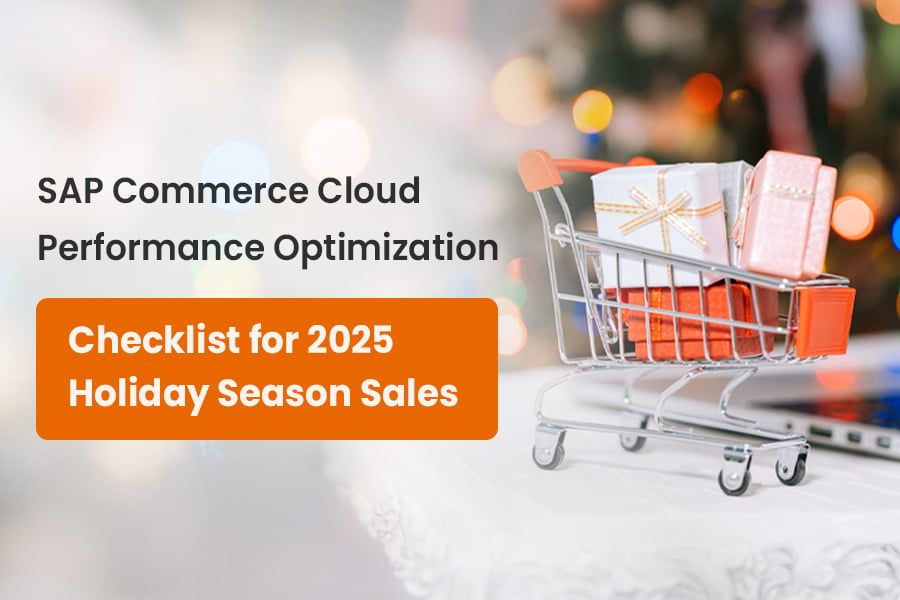Prepare your SAP Commerce Cloud for Holiday 2025 with a step-by-step performance optimization checklist to ensure fast, reliable, and high-converting shopping experiences.
The holiday shopping season represents the ultimate stress test for e-commerce platforms. With Black Friday, Cyber Monday, and year-end sales driving unprecedented traffic spikes, your SAP Commerce Cloud infrastructure needs to be battle-ready.
This blog provides actionable optimization strategies and a practical checklist to ensure your SAP Commerce Cloud platform delivers exceptional performance when it matters most.
Holiday season is unique in that it brings:
- Traffic spikes 100% above normal levels
- Concentrated load periods during flash sales and promotional events
- Mobile-heavy browsing with over 70 - 75% of traffic from mobile devices
- Global audience reach across multiple time zones
- Complex promotional scenarios with dynamic pricing and inventory updates
These patterns demand a multi-layered approach to performance optimization that goes beyond standard tuning practices.
At Knack Systems, we are invested in keeping our clients’ systems up and running at all times so they can celebrate the Holiday Season with confidence.
The Numbers That Will Determine Your 2025 Holiday Success
A hidden performance crisis could cost you your holiday revenue. In the 2024 holiday season, e-commerce sites with poor performance scores lost substantial revenue, not from crashes, but from invisible slowdowns that frustrated customers and buried search rankings.
Conversion rates drop an average of 4.42% with each additional second of load time (between 0-5 seconds). Recent studies suggest the impact is even greater due to rising user expectations. A complete site crash during peak hours can devastate both your revenue and brand reputation.
53% of mobile users abandon sites that take longer than 3 seconds to load- Google (2023)
The following metrics determine whether customers complete purchases or abandon your site and whether you show up in Google search results when it matters most.
LCP (Largest Contentful Paint) - Page Load Speed: This measures how fast customers see your Black Friday deals and product images. Anything over 2.5 seconds costs you 4-7% of conversions per additional second of delay.
INP (Interaction to Next Paint) - Click Responsiveness: This tracks how quickly "Add to Cart" and "Checkout" buttons respond. Delays over 200ms make customers think your site has crashed during peak traffic, triggering immediate abandonment.
CLS (Cumulative Layout Shift) - Visual Stability: This measures whether page elements jump around, causing accidental clicks. Scores above 0.1 signal an unprofessional experience that erodes customer trust.
Poor scores push your site down in search rankings exactly when holiday shoppers are searching for deals, handing traffic directly to faster competitors. Sites scoring "Poor" on these metrics lose 15-30% of potential conversions during high-traffic events compared to "Good" scoring competitors.
Core Web Vitals Benchmarks Metric for Ecommerce website
| Metric | Good | Needs Improvement | Poor |
|---|---|---|---|
| LCP (Page Load Speed) | ≤2.5s | ≤4s | >4s |
| INP (Click Responsiveness) | <=200ms | <=500ms | >500ms |
| CLS (Visual stability) | ≤0.1 | ≤0.25 | >0.25 |
Database Performance Optimization
Slow database queries are the silent killer of eCommerce performance. Customers expect lightning-fast responses, delays lead to abandoned carts.
Action Steps:
- Index strategically: Identify and index your most-queried tables, especially product catalogs, pricing, and inventory tables
- Monitor continuously: Set up automated database health checks to catch performance degradation early
- Optimize queries: Review and refine complex queries that run during checkout and product search
- Archive old data: Move historical transaction data to separate storage to keep operational databases lean
Pro Tip: Run query performance analysis monthly, not just before peak season. Problems caught early are easier to fix.
Accelerate Page Load Times
Every millisecond matters. Fast pages keep customers engaged and boost conversion rates.
Implement Lazy Loading:
- Defer loading of non-critical models and data until needed
- Load product images progressively as users scroll
- Delay loading of below-the-fold content
Streamline Catalog Synchronization
Catalog sync processes can bottleneck your entire system during peak traffic.
Best Practices:
- Restructure item types and attributes to eliminate redundant synchronization steps
- Schedule major catalog updates during off-peak hours
- Critical: Complete all master data updates at least 2 weeks before peak season begins
- Implement incremental sync for large catalogs rather than full synchronization
Coordinate with business teams to freeze non-essential product updates during Black Friday, Cyber Monday, and other high-traffic events.
Strategic Caching Implementation
Caching is your secret weapon for handling traffic surges without infrastructure overload.
Multi-Layer Caching Strategy:
- Application layer: Cache frequently accessed product data, categories, and search results
- Database layer: Implement query result caching for common searches
- CDN layer: Serve static assets from edge locations worldwide
To build lightning-fast headless sites with CMS like Contentful, a smart GraphQL caching strategy is essential. This multi-layered approach ensures your data is always served from the fastest possible location.
- Strategy: A multi-layered approach to serve data from the fastest location.
- Layers: Combines a client-side cache (for instant navigation) and a CDN/Edge cache (for fast initial loads).
- Syncing: Uses CMS like Contentful webhooks for smart invalidation, automatically purging specific stale data on update.
- Goal: To build high-performance, scalable applications with a superior user experience
Peak Season Focus: Pre-warm caches with hot products and popular categories before major sales events begin.
API Performance Optimization (Critical for Headless/Composable)
- OCC API response time optimization
- GraphQL query optimization for Spartacus
- API gateway caching and rate limiting
- Microservices communication optimization
Data Retention & Cleanup
Excessive data accumulation silently degrades performance over time.
Balance Retention with Performance:
- Retain audit logs, import records, and integration logs as required for compliance
- Archive data older than 90 days to separate storage
- Implement automated cleanup jobs for cronjob logs and temporary data
- Monitor database growth weekly during peak preparation
Resource Utilization Management
Server resources are finite so maximize them strategically.
CPU & Memory Optimization:
- Deploy monitoring tools like Dynatrace to track real-time resource usage
- Identify and eliminate performance bottlenecks before they impact customers
- Configure auto-scaling rules to handle traffic spikes automatically
- Tune JVM memory settings for optimal performance under load
When to Act: If CPU consistently exceeds 70% or memory usage hits 80%, it's time to optimize or scale up.
Unified Pricing & Promotions
Inconsistent pricing across channels frustrates customers and kills conversions.
SAP Omnichannel Promotion Pricing Benefits:
- Apply identical promotional rules across web, mobile, and in-store
- React instantly to competitor pricing changes
- Launch flash sales and limited-time offers with confidence
- Eliminate pricing errors that damage customer trust
AI-Powered Personalization
Personalization drives conversions.
Intelligent Recommendation Strategy:
- Analyze browsing history and purchase patterns in real-time
- Surface complementary products and upsell opportunities
- Optimize search results based on individual user behavior
- Display products with highest purchase probability for each visitor
Content Delivery Network (CDN) Excellence
Your CDN is your first line of defense against slow global performance.
Pre-Season CDN Checklist:
- Verify all static assets (images, CSS, JavaScript) route through CDN
- Enable aggressive caching with proper cache-control headers
- Test CDN performance in all target geographic markets
- Set up CDN monitoring and alerting for latency spikes
- Schedule cache purges before major product launches
Don't Overlook: Regional CDN performance varies. Test from multiple locations, especially your top customer markets.
Third-Party Integration Resilience
External integrations—payment gateways, tax calculators, personalization engines—can become your weakest link.
Proactive Integration Management:
- Monitor response times and uptime for all critical integrations with APM tools
- Configure alerts for slowdowns or outages
- Implement fallback mechanisms for payment processors and recommendation engines
- Load test with all integrations active to simulate real-world conditions
Failure Scenario Planning: What happens if your primary payment gateway goes down on Black Friday? Have a plan.
Disaster Recovery Readiness
Downtime during peak season isn't just costly—it can be catastrophic for your brand.
Essential DR Components:
Backup Strategy:
- Automated daily backups of all critical databases
- Offsite backup storage with versioning
- Regular backup restoration tests (quarterly minimum)
Recovery Planning:
- Document clear step-by-step recovery procedures
- Define and test RTO (Recovery Time Objective) and RPO (Recovery Point Objective)
- Conduct disaster recovery drills at least twice before peak season
- Maintain updated escalation contacts for technical teams and vendors
Advanced Options:
- Evaluate active-active or active-passive multi-region deployments for business-critical operations
- Consider hot standby environments for instant failover
Remember: The best disaster recovery plan is the one you've actually tested.
Your Peak Season Timeline
8 Weeks Before:
- Complete infrastructure audit
- Optimize database and queries
- Implement caching strategies
6 Weeks Before:
- Finish all master data updates
- Test all integrations under load
- Verify CDN configuration
4 Weeks Before:
- Conduct full load testing
- Execute disaster recovery drill
- Train support teams on escalation procedures
2 Weeks Before:
- Freeze non-essential catalog changes
- Pre-warm caches
- Final system health checks
Peak Season:
- Monitor in real-time
- Keep war room staffed
- Execute contingency plans if needed
Peak season preparation isn't a one-time project—it's a continuous process of optimization, testing, and refinement. The platforms that perform flawlessly during the holiday rush are built by teams that start preparing months in advance.
Don't wait until November to think about Black Friday. Start optimizing today.
Need expert guidance on SAP Commerce Cloud performance optimization? Knack Systems specializes in preparing enterprise platforms for peak performance. Let's ensure your platform is ready for whatever the season throws at it.
Connect with our ecommerce expert.
Liked this information? Subscribe to our blog.




